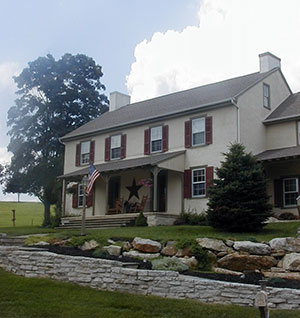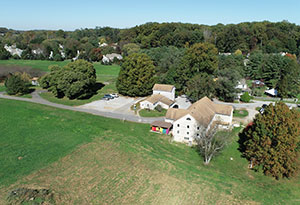Design Elements — Preserve Historic Resources and their Context
The preservation of historic buildings and features can be encouraged by allowing their inclusion in the open space calculations and allowing for adaptive reuse of the structures. Historic buildings could be used for several purposes in the subdivision including public uses (e.g., community meeting place), commercial establishments (e.g., bed and breakfast or daycare), residential uses, or the building's original function could be maintained (e.g., farmhouse or barn). Where a farmhouse and/or barn are preserved, permanently protected agricultural land could be divided off with these structures and could potentially be counted towards the open space requirement. Maintaining the open space around historic structures preserves the historic landscape and context, contributing to a more meaningful preservation effort.
Ordinance Considerations
- The zoning ordinance can include incentives for the preservation of historic structures on the site. For example, a use that might not otherwise be allowed in the zoning district, such as an office or antique shop, could be permitted in the historic structure in exchange for its preservation. Allowing an additional new dwelling unit (or not counting a dwelling in an historic resource towards the total number of permitted units) could also serve as an incentive. Incentives for the preservation of historic structures can be incorporated into the ordinance so that it applies to the entire municipality, not just in conservation subdivisions.
- When an agricultural property is retained, enough open space should be retained around the property to preserve its agricultural viability. Similarly, if an historic property is retained, a municipality may choose to ensure its lot is large enough to preserve its historic context.
- Municipalities can decide whether the ordinance should allow an historic house lot within the subdivision to count toward the overall open space requirement. These lots may contribute scenic vistas to the development and provide an additional historic preservation incentive but will not be open to public use.
- Ordinances should define 'historic resource' so it is clear which structures are eligible for preservation incentives.
- Some municipalities choose to address historic resource preservation within the base zoning district, and some choose to establish an overlay district that applies supplemental regulations to the base district. The sample language provided in the Sample Ordinance Section is for an Historic Preservation Overlay District in a municipal zoning ordinance. These provisions could also be considered if the municipality wants to implement a broader preservation program. A full set of provisions would cover other historic preservation issues, such as delay of demolition, in addition to allowing a broader range of uses in historic resources. The list of permitted use opportunities, maximum square footage, and number of employee requirements in the ordinance, should be tailored for each municipality. In rural areas, a more limited range of uses might be appropriate. The ordinance language also allows for the modification of area and bulk regulations through the conditional use process if it promotes the preservation of an historic resource.
Sample Ordinance Language — Special Provisions for Historic Structures
Historic resources shall be preserved to the greatest degree possible through inclusion in development plans and design, including historic buildings, structures, sites, objects, ruins, paths, trails, or any other historic landscape features. Additional use opportunities and modifications to area and bulk regulations may be permitted on properties with historic resources.
Additional Use Opportunities for Historic Resources
Subject to obtaining conditional use approval from the governing body, the following use opportunities may be permitted in place of or in addition to uses permitted in the underlying zoning district. Where such use is already permitted by right or by special exception in the underlying district and is the only use proposed on the lot, it shall not be subject to the provisions of this section, but shall meet all other applicable ordinance requirements.
- Bed and breakfast*
- Business, administrative, or professional office employing not more than five (5) persons.
- Artist studio or craft workshop employing not more than three (3) persons. Where instructional classes are provided, the use shall be limited to one (1) class at a time with not more than ten (10) students in the class and not more than two (2) instructors.
- Antiques store of one thousand five hundred (1,500) square feet or less of gross leasable floor area.
- Accessory apartment/ residential conversion** of the conversion of non-residential use.
- Personal service shop including beauty salon, barber, tailor, dressmaker, or similar shop, but not including dry cleaning or laundromat, and shall be limited to one (1) employee per five hundred (500) square feet of gross leasable floor area devoted to this personal service use, up to a maximum of one thousand five hundred (1,500) square feet.
- Repair services for small scale uses such as small appliances, watches, household furnishings, shoes, bicycles, and locks, but shall not include automobile, truck, motorcycle, or lawnmower repair, and shall be limited to one (1) employee per five hundred (500) square feet of gross leasable floor area devoted to the personal service use, up to a maximum of one thousand five hundred (1,500) square feet.
- Optional — Other uses of a similar nature as determined by the governing body.
*Note: Supplemental use standards for bed and breakfasts should be included elsewhere in the zoning ordinance.
**Note: Supplemental use standards for residential conversions should be included elsewhere in the zoning ordinance.
Modification to Area and Bulk Regulations
The governing body, through the granting of a conditional use, may approve requested modifications to applicable lot area, lot width, or yard requirements or design standards otherwise applicable in the underlying zoning district for plans affecting historic resources.
- Such modifications may be permitted to reduce otherwise applicable requirements to the minimum degree necessary to accommodate proposed plans, and to allow for the preservation and rehabilitation and/or reuse of the historic resource.
- For residential lots, where an historic resource exists on a site that is to be subdivided or developed, there shall be included a lot area of sufficient size to preserve those portions and features of the historic resource which are historically and architecturally significant and to the extent possible, the context of the resource.
Requirements for Conditional Use Approval
In addition to the conditional use standards set forth in section of this ordinance, the following requirements shall apply where additional use opportunities and/or modification to applicable area and bulk regulations for historic resources are permitted:
- The modification shall have the effect of encouraging the continued protection or reuse of the historic resource.
- The approval of the conditional use is deemed by the governing body to be necessary to the preservation of the historic resource.
- The approval of the conditional use will be deemed by the governing body to have no adverse effect on adjoining properties.
- Where plans involving historic resources under this Section result in all or portions of any such resource remaining unoccupied, the municipality may require that such unoccupied resource shall be tightly sealed and barred off in a manner not jeopardizing historical integrity, and the utilities turned off for safety.
- The governing body shall be satisfied that adequate water supply and sewage disposal can be provided for all permitted uses.
- The governing body may require as a condition of approval the establishment of a façade easement, conservation easements, or other means to guarantee permanent protection of the historical integrity of the subject resources.
- Except where clearly detrimental to the historical integrity and where public health, safety, and welfare are otherwise adequately provided for, all other applicable standards contained in this ordinance shall be complied with, including, but not limited to, requirements for buffering, lighting, storage, loading, parking, and signage.
- The applicant should maintain sufficient landscaped or buffer area and yard area surrounding the historic resource to retain the integrity of the historic landscape and setting. The applicant can mitigate impacts to the historic landscape and setting through appropriate vegetation or through screening compatible with such historic landscape and setting, and through retaining the view shed which visually links historic resources to their setting.
- The Historical Commission shall review all requests for conditional use approval regarding historic resources related to requested area and bulk modifications and evaluate whether requested modifications are necessary for the preservation, and are compatible with maintaining the historical integrity of the historic resource. Recommendations shall be in a written report to the governing body.
- Plans involving any rehabilitation, alteration, or enlargement of an historic resource proposed as part of the conditional use application shall use as a guideline the Secretary of the Interior Standards for Rehabilitation. Such plans shall be reviewed by the Historical Commission who shall submit a written review to the governing body, and the plans submitted shall be in sufficient detail to allow the determination of their level of compliance with the standards. In approving the conditional use, the governing body may set conditions requiring compliance with the Secretary of the Interior's Standards for Rehabilitation, as applicable.
Bonus for Historic Resource Preservation
A municipality may also want to include the following bonus for the preservation of an historic resource on the site.
- If there is an existing historic resource on the tract that is proposed to remain in residential use upon development of the site, that historic resource shall not be counted towards the permitted number of dwelling units on the tract. The governing body may require as a condition of bonus approval the establishment of a façade easement, conservation easements, or other means to guarantee permanent protection of the historical integrity of the subject resource.




